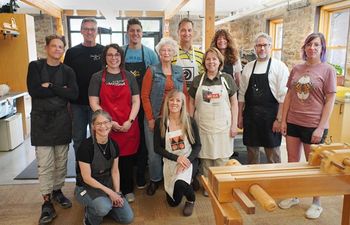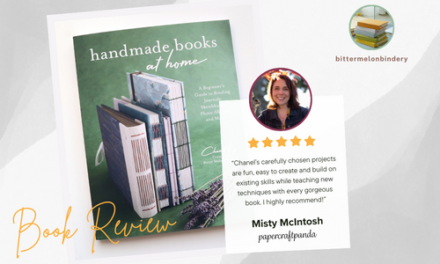In June of 2022, I attended a week-long Intro to Bookbinding Level II course at the American Academy of Bookbinding. It was the first of two planned visits and the best week of my life. On the trip home, I started writing down all of the incredible things I learned. Today, I want to share my top three with you.
- Learning from a fellow bookbinder is priceless
- Materials are important
- Even highly experienced bookbinders make mistakes

Learning from another bookbinder is priceless
I’m living proof that you can learn anything online. For the past 6+ years, I’ve been teaching myself how to make books by following the guidance posted by others on YouTube, Instagram and blogs. Every person’s approach is different, so I take what makes sense to me and leave the rest behind. My success is the entire reason I started this blog in the first place. If I can learn online, so can you.
While I’ve learned a lot online, I accomplished a number of wins at the AAB. Many of these wins would have taken dozens of hours of trial and error to figure out. I watched a fellow bookbinder execute common steps using completely different techniques I’d never thought of. Many of the methods used less materials and time, making them more efficient and cost effective. Other techniques focused on easy ways to improve accuracy, something we can always improve on as crafters.
In short, it’s worth the investment to work directly with an experienced bookbinder who can open your eyes to new ways of doing things. If you don’t have a bookbinder near you, find one online with content detailed enough to follow. While there are many teachers, only a handful will speak your “language” of learning (more/less detail, more/less visuals etc.). Try to find the ones that do.

Materials are important
Book making materials can be overwhelming for new binders. I know, because I’ve been there. The key is to focus on simple materials that will get the job done. It doesn’t make sense to invest in more expensive materials until you’re ready to take your bookbinding up a notch.
I’m at the point where I’m ready to explore new materials that add the right strength, flexibility or moisture resistance to my books. While at the AAB, I learned about material variations that seem insignificant, but truly make all the difference.
A great example is Mylar.
Mylar is a clear plastic film bookbinders can use to prevent moisture from absorbing into the book block. Baking parchment will do the same (for a lot less money), so I was a little confused. Eventually, I asked my instructor why it was worth the additional expense. She gave me three great reasons:
- Mylar is firm, but flexible with a stiff edge that sits nicely inside the book hinge while pressing or drying
- It’s crystal clear, so positioning it in the right place is easy
- Mylar is acid-free, while baking parchment is not
These reasons make a huge difference when creating a fine binding worth hundreds or thousands of dollars.
In the coming weeks, I’ll share more of these material variations with you. Stay tuned!
Even highly experienced bookbinders make mistakes
There is a stack of books in my office I refuse to sell or give away. I don’t keep them because they’re extra special or important to me. I keep them because I feel they’re not good enough.
Some have winkles on the inside hinge that formed while drying. A few have crooked endpapers that are not perfectly aligned. At least two of them have bulky corners because I didn’t cut away enough material before folding.
There is a shelf at the AAB full of books made by the greats. As I opened the front cover of one book, I saw a wrinkle on the inner hinge. It looked just like mine. I asked the instructor if this was acceptable and she looked at me like I was from Mars. “Of course it’s acceptable,” she said. “No book is perfect. Only machines are capable of perfection.”
As the class pressed on, I saw this same instructor with 20+ years of experience make a bunch of mistakes. She got frustrated, just like me. When a mistake was especially bad, she started over. I’ve done that, too.
At one point, she hissed at the class to be quiet. The testy piece of leather she’d been manipulating for 5 or so minutes was beginning to dry. Time was running out. No one in the room was offended. We all know what that feels like. We’ve all been there before.
Learning online can feel like working in a lab without windows. Everyone posts their best work, but few post their mistakes. Over time, our idea of what is acceptable becomes unrealistic. In these moments, I want you to remember what I learned in Telluride: only machines are capable of perfection. We’re humans, not machines. Our books will have subtle mistakes, just like the greats.
Stay tuned for more learnings from the American Academy of Bookbinding!
In July, I’m headed back to the AAB for a 2-week class all about the Fundamentals of Half Leather Bindings. If you’re interested in leather work, stay tuned – I plan to share everything I learn with you!

Thanks so much for letting me share this with you today. I hope it was entertaining, if not helpful.
More bookbinding goodness
✨ What tools do I need to get started bookbinding?
- Bookbinding Tools & Supplies Quick Start Guide – learn all about book making tools, which to buy first & where to go online
- Pick up my popular Complete Starter Bookbinding Tools Kit – all the bookbinding essentials in one spot
🌟 Looking for a simple way to start making books?
Try a Complete Book Materials Kit. Each one has everything you need (+ tutorials & videos) to make a beautiful book without all the fuss.
Thank you for taking me along on your book making journey!
Misty












